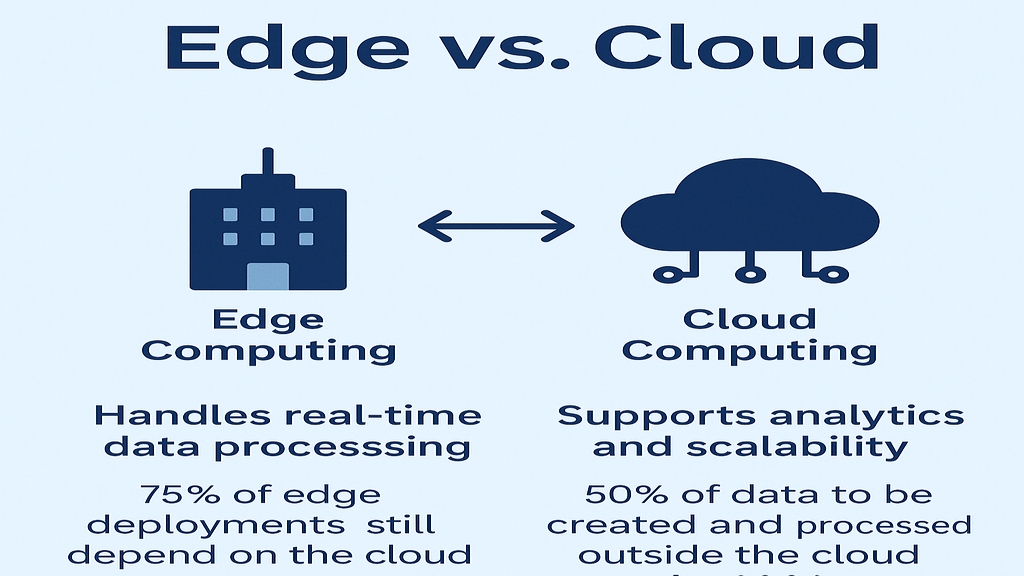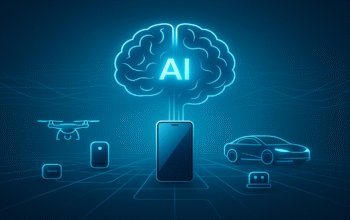Federated Learning at the Edge: Collaborative AI Without Data Centralization
Imagine a world in which smartwatches, cellphones, and even automobiles can learn from each other without ever exchanging your location, private messages, or images. No information is sent to the cloud—no tech giants mining information. Only intelligent gadgets can learn from one another.
It’s not just a pipe dream. It’s edge federated learning, a cutting-edge AI technique transforming machine learning while securely storing your data on your device.
This decentralized method is tackling one of the biggest problems in technology, from autonomous cars to medicine: How can we develop powerful AI without compromising privacy?
Let’s examine the operation of federated learning at the edge, its significance, and how it is already upending businesses.
Covered Contents
ToggleThe Centralized Data Trap: Why Old AI Models Fail Us
Traditional AI works like this:
– Collect data from millions of users.
– Send it to a central server.
– Train a model using that data.
– Push the updated model back to devices.
This centralized approach powered innovations like Alexa and Netflix recommendations. But it has three fatal flaws:
-Privacy risks: Your data is stored (and hacked) in vulnerable central servers.
-High costs: Moving massive datasets to the cloud burns bandwidth and money.
-One-size-fits-all models: A New Yorker’s Uber app gets the same updates as a farmer in Kenya—even if their needs differ wildly.
In 2023, 80% of companies admitted they hoard user data “just in case” it’s useful later. Meanwhile, laws like GDPR and CCPA are forcing firms to rethink this model.
Enter federated learning at the edge—a privacy-first alternative.
What is Federated Learning at the Edge?
Federated learning (FL), a machine learning technique for artificial intelligence, allows models to learn collectively across thousands of devices without ever leaving those devices.
Here’s how:
Step 1: Devices (like smartphones) receive a “starter” AI model from a central server.
Step 2: The model is trained locally by the devices using their data.
To autocomplete text, your phone learns how you type.
A factory sensor picks up on machine defects.
Step 3: Devices provide the server with just the updated model, not the raw data.
Step 4: These updates are combined by the server to create a more intelligent global model.
Repeat: The loop continues once the upgraded model is returned to the devices.
By processing data on the device rather than a local server, edge computing expedites this process. Together, they provide a safe and effective cycle, learn locally, and work together internationally.
Why Federated Learning at the Edge is a Game-Changer
1. Privacy by Design: Your Data Never Leaves Your Device
Using patient scans, a hospital may train an AI to identify cancer without the images ever leaving the hospital’s servers.
Google’s Gboard uses federated learning to improve typing suggestions. Your phone keeps your messages.
Factual statement: Apple trains Siri using federated learning. Apple’s servers never receive your voice recordings.
2. Quicker, More Intelligent Models
Diversity in the actual world is difficult for centralized AI to handle. For example:
A weather app designed for California won’t function during the Mumbai monsoon.
Models can learn from their local environment, thanks to federated learning. One smartphone in Dubai learns how to detect sandstorms, while another in Norway learns about snowy roads.
Result: A personalized AI that is aware of your environment.
3. Cost Efficiency
Data transmission to the cloud is expensive. AI training on-device lowers costs: General Electric uses federated learning to study aircraft engines. Each engine trains a model locally instead of transmitting terabytes of sensor data. Only 2MB of updates are made every cycle.
-Savings on bandwidth: According to MIT research, federated learning can reduce data transfer by 99%.
4. Simple Compliance
GDPR and other data protection laws require companies to store data locally. Federated learning makes compliance easier.
-The data of a European user stays in Europe.
-Local data sovereignty laws are taken into consideration by a model trained in Japan.5.
5- Democratizing AI
Smaller businesses (or countries) can collaborate on AI projects without providing tech giants with their data. For example,
-Farmers in Brazil and Kenya could work together to create a crop prediction model without disclosing private yield data.
-By adding to (but not giving up) their patient data, rural Indian hospitals can gain access to actual diagnostics.
Real-World Applications: Where Federated Learning at the Edge is Shining
Healthcare: Saving Lives Without Sacrificing Privacy
Project InnerEye: Hospitals can collaborate to train AI to analyze MRI data using Microsoft’s FL tool. Each hospital’s patient data is kept private, but the model learns from global trends.
Plague Response: During COVID-19, researchers used data from local clinics and federated learning to predict outbreaks without disclosing personal information.
Autonomous Vehicles: More Intelligent Automobiles, Securer Roads
Data from real-world driving is used to train Tesla’s vehicles. All of the Teslas worldwide become smarter when one car in Tokyo notices an odd road situation, but the data of the Tokyo drivers stays within the vehicle.
Automakers may collaborate and create self-driving AI without disclosing confidential secrets thanks to NVIDIA’s FL technology.
Retail: Personalized Shopping Experience Without the Unsettling Ambience
Walmart uses FL for video analysis of in-store surveillance. Each store teaches a model for increasing shelf stock, but the video clips do not.
– Alibaba’s Fashion AI makes outfit recommendations based on your personal style preferences without requiring you to provide photos.
Finance: Privacy-Preserving Anti-Fraud Measures
Federated learning is used by JPMorgan Chase institutions to detect money laundering.
The global model detects suspicious activity worldwide, whereas branches train models locally on transaction patterns in the neighborhood.
Challenges: Why Federated Learning Isn’t Perfect Yet
Edge federated learning is innovative, but it has drawbacks:
1. Barriers to communication
Networks are taxed by sending model updates to millions of devices.
Approach: Qualcomm and other companies are developing “sparse updates” that would only send necessary modifications to devices.
2. Inequality of Data
Poor data from devices like old smartphones can harm model quality.
Approach: Google’s “FedProx” algorithm allocates weight to each update depending on data quality.
3. Security Risks
By sending false updates, hackers can contaminate models.
Approach: Only authorized devices may validate updates, thanks to IBM’s use of blockchain technology.
4. Device Constraints
AI training on a smartwatch is more challenging than on a supercomputer.
Approach: TensorFlow Lite and other “TinyML” frameworks improve models for low-power devices.
The Future of Federated Learning at the Edge
Federated learning (FL) seems to have a bright and collaborative future, particularly on the edge, where AI may continuously improve itself. Imagine wearables that can detect cardiac abnormalities as soon as they appear or traffic lights that can automatically adapt to calm traffic. Federated learning (FL) enables various sectors to collaborate without revealing sensitive data. Cities, weather services, and automobile makers can all cooperate. Collectively, they can train strong AI systems for responding to disasters. Such collaboration can make systems smarter and safer for everyone. Data philanthropy is a movement in which consumers can choose to “donate” device updates to help causes like climate science and possibly get cryptocurrency rewards in return. To aid in this process, governments are also intervening and supporting FL programs that reduce dependency on Big Tech.
For example, the EU GAIA-X initiative is using federated learning to protect European data and create digital sovereignty.
Conclusion: AI’s Silent Revolution
Edge federated learning is a mentality more than a technological breakthrough. It shows that innovation does not have to come at the expense of privacy. Centralization is not required for that alliance.
This decentralized approach is creating smarter, fairer, and more human-like AI for use in everything from autonomous vehicles to disease diagnosis. Keep this in mind the next time your watch monitors your heart rate or your phone automatically corrects a message. AI won’t be located in the cloud. You’re holding it in your hand.
Learn about Centralization and Decentralization



